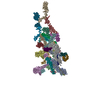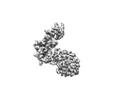+ Open data
Open data
- Basic information
Basic information
| Entry |  | |||||||||
|---|---|---|---|---|---|---|---|---|---|---|
| Title | The cryo-EM structure of the NTD2 from the X. laevis Nup358 | |||||||||
 Map data Map data | The NTD2 of Nup358 | |||||||||
 Sample Sample |
| |||||||||
 Keywords Keywords | CR / NPC / nucleoporin / Nup358 / Nup93 STRUCTURAL PROTEIN / STRUCTURAL PROTEIN | |||||||||
| Function / homology |  Function and homology information Function and homology informationmRNA transport / nuclear pore / GTPase activator activity / protein transport / nuclear membrane / DNA binding / zinc ion binding / cytoplasm Similarity search - Function | |||||||||
| Biological species | ||||||||||
| Method | single particle reconstruction / cryo EM / Resolution: 3.0 Å | |||||||||
 Authors Authors | Shi Y / Zhan X / Huang G | |||||||||
| Funding support |  China, 1 items China, 1 items
| |||||||||
 Citation Citation |  Journal: Science / Year: 2022 Journal: Science / Year: 2022Title: Structure of the cytoplasmic ring of the nuclear pore complex. Authors: Xuechen Zhu / Gaoxingyu Huang / Chao Zeng / Xiechao Zhan / Ke Liang / Qikui Xu / Yanyu Zhao / Pan Wang / Qifan Wang / Qiang Zhou / Qinghua Tao / Minhao Liu / Jianlin Lei / Chuangye Yan / Yigong Shi /  Abstract: INTRODUCTION The nuclear pore complex (NPC) resides on the nuclear envelope (NE) and mediates nucleocytoplasmic cargo transport. As one of the largest cellular machineries, a vertebrate NPC consists ...INTRODUCTION The nuclear pore complex (NPC) resides on the nuclear envelope (NE) and mediates nucleocytoplasmic cargo transport. As one of the largest cellular machineries, a vertebrate NPC consists of cytoplasmic filaments, a cytoplasmic ring (CR), an inner ring, a nuclear ring, a nuclear basket, and a luminal ring. Each NPC has eight repeating subunits. Structure determination of NPC is a prerequisite for understanding its functional mechanism. In the past two decades, integrative modeling, which combines x-ray structures of individual nucleoporins and subcomplexes with cryo-electron tomography reconstructions, has played a crucial role in advancing our knowledge about the NPC. The CR has been a major focus of structural investigation. The CR subunit of human NPC was reconstructed by cryo-electron tomography through subtomogram averaging to an overall resolution of ~20 Å, with local resolution up to ~15 Å. Each CR subunit comprises two Y-shaped multicomponent complexes known as the inner and outer Y complexes. Eight inner and eight outer Y complexes assemble in a head-to-tail fashion to form the proximal and distal rings, respectively, constituting the CR scaffold. To achieve higher resolution of the CR, we used single-particle cryo-electron microscopy (cryo-EM) to image the intact NPC from the NE of oocytes. Reconstructions of the core region and the Nup358 region of the CR subunit had been achieved at average resolutions of 5 to 8 Å, allowing identification of secondary structural elements. RATIONALE Packing interactions among the components of the CR subunit were poorly defined by all previous EM maps. Additional components of the CR subunit are strongly suggested by the EM maps of 5- to 8-Å resolution but remain to be identified. Addressing these issues requires improved resolution of the cryo-EM reconstruction. Therefore, we may need to enhance sample preparation, optimize image acquisition, and develop an effective data-processing strategy. RESULTS To reduce conformational heterogeneity of the sample, we spread the opened NE onto the grids with minimal force and used the chemical cross-linker glutaraldehyde to stabilize the NPC. To alleviate orientation bias of the NPC, we tilted sample grids and imaged the sample with higher electron dose at higher angles. We improved the image-processing protocol. With these efforts, the average resolutions for the core and the Nup358 regions have been improved to 3.7 and 4.7 Å, respectively. The highest local resolution of the core region reaches 3.3 Å. In addition, a cryo-EM structure of the N-terminal α-helical domain of Nup358 has been resolved at 3.0-Å resolution. These EM maps allow the identification of five copies of Nup358, two copies of Nup93, two copies of Nup205, and two copies of Y complexes in each CR subunit. Relying on the EM maps and facilitated by AlphaFold prediction, we have generated a final model for the CR of the NPC. Our model of the CR subunit includes 19,037 amino acids in 30 nucleoporins. A previously unknown C-terminal fragment of Nup160 was found to constitute a key part of the vertex, in which the short arm, long arm, and stem of the Y complex meet. The Nup160 C-terminal fragment directly binds the β-propeller proteins Seh1 and Sec13. Two Nup205 molecules, which do not contact each other, bind the inner and outer Y complexes through distinct interfaces. Conformational elasticity of the two Nup205 molecules may underlie their versatility in binding to different nucleoporins in the proximal and distal CR rings. Two Nup93 molecules, each comprising an N-terminal extended helix and an ACE1 domain, bridge the Y complexes and Nup205. Nup93 and Nup205 together play a critical role in mediating the contacts between neighboring CR subunits. Five Nup358 molecules, each in the shape of a shrimp tail and named "the clamp," hold the stems of both Y complexes. The innate conformational elasticity allows each Nup358 clamp to adapt to a distinct local environment for optimal interactions with neighboring nucleoporins. In each CR subunit, the α-helical nucleoporins appear to provide the conformational elasticity; the 12 β-propellers may strengthen the scaffold. CONCLUSION Our EM map-based model of the CR subunit substantially expands the molecular mass over the reported composite models of vertebrate CR subunit. In addition to the Y complexes, five Nup358, two Nup205, and two Nup93 molecules constitute the key components of the CR. The improved EM maps reveal insights into the interfaces among the nucleoporins of the CR. [Figure: see text]. | |||||||||
| History |
|
- Structure visualization
Structure visualization
| Supplemental images |
|---|
- Downloads & links
Downloads & links
-EMDB archive
| Map data |  emd_31602.map.gz emd_31602.map.gz | 28.5 MB |  EMDB map data format EMDB map data format | |
|---|---|---|---|---|
| Header (meta data) |  emd-31602-v30.xml emd-31602-v30.xml emd-31602.xml emd-31602.xml | 15.7 KB 15.7 KB | Display Display |  EMDB header EMDB header |
| Images |  emd_31602.png emd_31602.png | 35.9 KB | ||
| Filedesc metadata |  emd-31602.cif.gz emd-31602.cif.gz | 7.4 KB | ||
| Archive directory |  http://ftp.pdbj.org/pub/emdb/structures/EMD-31602 http://ftp.pdbj.org/pub/emdb/structures/EMD-31602 ftp://ftp.pdbj.org/pub/emdb/structures/EMD-31602 ftp://ftp.pdbj.org/pub/emdb/structures/EMD-31602 | HTTPS FTP |
-Validation report
| Summary document |  emd_31602_validation.pdf.gz emd_31602_validation.pdf.gz | 541.1 KB | Display |  EMDB validaton report EMDB validaton report |
|---|---|---|---|---|
| Full document |  emd_31602_full_validation.pdf.gz emd_31602_full_validation.pdf.gz | 540.7 KB | Display | |
| Data in XML |  emd_31602_validation.xml.gz emd_31602_validation.xml.gz | 5.5 KB | Display | |
| Data in CIF |  emd_31602_validation.cif.gz emd_31602_validation.cif.gz | 6.3 KB | Display | |
| Arichive directory |  https://ftp.pdbj.org/pub/emdb/validation_reports/EMD-31602 https://ftp.pdbj.org/pub/emdb/validation_reports/EMD-31602 ftp://ftp.pdbj.org/pub/emdb/validation_reports/EMD-31602 ftp://ftp.pdbj.org/pub/emdb/validation_reports/EMD-31602 | HTTPS FTP |
-Related structure data
| Related structure data |  7filMC  7fikC M: atomic model generated by this map C: citing same article ( |
|---|---|
| Similar structure data | Similarity search - Function & homology  F&H Search F&H Search |
- Links
Links
| EMDB pages |  EMDB (EBI/PDBe) / EMDB (EBI/PDBe) /  EMDataResource EMDataResource |
|---|---|
| Related items in Molecule of the Month |
- Map
Map
| File |  Download / File: emd_31602.map.gz / Format: CCP4 / Size: 30.5 MB / Type: IMAGE STORED AS FLOATING POINT NUMBER (4 BYTES) Download / File: emd_31602.map.gz / Format: CCP4 / Size: 30.5 MB / Type: IMAGE STORED AS FLOATING POINT NUMBER (4 BYTES) | ||||||||||||||||||||||||||||||||||||
|---|---|---|---|---|---|---|---|---|---|---|---|---|---|---|---|---|---|---|---|---|---|---|---|---|---|---|---|---|---|---|---|---|---|---|---|---|---|
| Annotation | The NTD2 of Nup358 | ||||||||||||||||||||||||||||||||||||
| Projections & slices | Image control
Images are generated by Spider. | ||||||||||||||||||||||||||||||||||||
| Voxel size | X=Y=Z: 1.387 Å | ||||||||||||||||||||||||||||||||||||
| Density |
| ||||||||||||||||||||||||||||||||||||
| Symmetry | Space group: 1 | ||||||||||||||||||||||||||||||||||||
| Details | EMDB XML:
|
-Supplemental data
- Sample components
Sample components
-Entire : Structure of the NPC Cytoplasmic Ring
| Entire | Name: Structure of the NPC Cytoplasmic Ring |
|---|---|
| Components |
|
-Supramolecule #1: Structure of the NPC Cytoplasmic Ring
| Supramolecule | Name: Structure of the NPC Cytoplasmic Ring / type: complex / ID: 1 / Parent: 0 / Macromolecule list: all |
|---|---|
| Source (natural) | Organism: |
-Macromolecule #1: Nup358 complex, clamps
| Macromolecule | Name: Nup358 complex, clamps / type: protein_or_peptide / ID: 1 / Number of copies: 1 / Enantiomer: LEVO |
|---|---|
| Source (natural) | Organism: |
| Molecular weight | Theoretical: 322.784344 KDa |
| Recombinant expression | Organism:  Homo sapiens (human) Homo sapiens (human) |
| Sequence | String: MRRSKAEIQR YVENAQNSAS SPREKSMKGF LFARLYYEAK EYELAKRSVS SYISVQERDP KAHRFLGQLF EIEGNVEKAV GCYKRSLEL NPTQKDLTLR IAELICTLNI KDGRAEYWVE RASKLFPGSP EIYRLKEQLL SSQGEAGWNQ LFDLIQAELF A RPNDVYVN ...String: MRRSKAEIQR YVENAQNSAS SPREKSMKGF LFARLYYEAK EYELAKRSVS SYISVQERDP KAHRFLGQLF EIEGNVEKAV GCYKRSLEL NPTQKDLTLR IAELICTLNI KDGRAEYWVE RASKLFPGSP EIYRLKEQLL SSQGEAGWNQ LFDLIQAELF A RPNDVYVN LKLVDLFLSN QRLEEAVLHC LKPERRALRT DIEWCSCVVR VFKEYLASKQ GQKNTNMRMI TKELLLAQCD VV FLTLSKK DVQKSKEALE RFDQALLSVK QSVSGTDASD LSVTFYEMRG HYYMHAGTLL LKMAQSCEVQ WKALIEPAAL CYL LAYQVP KPKSKPVKGD DNGQGFLEEL AFDRQSKSGH LLLTLSHGKQ NFISEIIETF ANQCGQSILL KFLFEDNLSM QDSF MGSDD ISYVENRVPD LSELSQHDNG SLRIHNGDLQ HLTWLGLQWH FLSTLPPLRK WLKQIFPRVP QETSRLESNI PESIC LLDL EVFLLAVVQT SYLQLQDNNT TADPNRPRCL PLPICKQLFT DRQRSWWDAV YSLITKKALP GTSAKLRSVI QHDLTT LRA QEKHGLQPAV LVNWARGLHK TGYSLNSFYD QKEYMGRCVH YWKKLLPLLD LVKQKKSIPE PVDPLFKHFH NKDIKVS EV KDLEDEACIA FATLDLVDGK TEDAIIAFES VKNVVAYWNL ALIYQRKAEE IENDCLPAEE QEEFQECLLK CKGFLKMI C DEYSAYPSIA TSLPVPVETV FEMLDSVKQS LGEAMDDHSP AFMENHSVLT TSAIKHSTPS PTKLTISPSK SARFSPKTP PRWAEDQKSL LEVLCNKVEA LKKEVQELKH NNSNANVSPH RWPNEGFESD TVADSYQGTQ NFYTVPLTVS TSGPAAYYGQ SPAYNSQHL LRPAANITPT KTSVYAMNRL PPQQHMYTYP QQMHTPPTQQ SSAGCVFPQE IYGPPLRFES PAAAILSPHN E EFYNYNVP PASTNPPLPE PGYFTKPSTA MQHSKQEVPK VSDFGKGCLG QSTSEGQKPS PFTVPMQSTP ASSTFKFNSN FK SNDGDFT FSSSHAGASS AYTGSESLLG LLTSDRPTQE QGKKSDFENI ASDEKNMFRF GEKSFSPGFT VTGTQSQDKN PLV FGQSEN IFTFKTPGKS TFKPPTFGTQ TKDAHNHSVE SDAGSEHVAD DDGPHFEPII PLPEKVEVKT GEEDEEEMFC NRAK LFRFD AETKEWKERG IGNVKILRHR LSGKIRLLMR REQVLKICAN HYINADMKLK PNATSDKSYV WHAYDYADEM PKPEQ LAIR FKTVDEAAHF KAKFEEAQRL LAMAEAPAIS AQHKNAKDNL KLDASKVKEA PLPFGSQFIL KRGEWQCDCC LATNAP TST SCVCCQTPNK NKSSSISSVC ISAPSFTFVK ESATNKLAFG QQLLKDKDQW TCSKCSQKND AGVSHCSSCQ TQSQAKA GI SQPNIASSGF TNNTSAQGDN LAAVFGKKAG QWDCDVCYVR NEPSANKCIS CQNTKPLSKV SGTQAASFSF AAGADNSQ K NFGAQFAKKE GQWDCDACYV RNEPLATKCI SCQNTKLLSK TTGTQAASFS FAAAADNSQK NFGGQFAKKE GQWDCSSCL VRNEASAPNC VACHSANPQI TNKDVVPPAL TPSGFKFGHN AEVGKTQQSL SAMFSCKQGQ WECSTCLVIN DAAKDTCAAC QAAKPGSSA SQSKEVPSTF GIKANSSQNF GQPAAGFNCG FSAKGFKFGI SDEKASASNF TFKAPATNEE TKMVKDGFNF P VSAGSLSF KFGISEPDKT KEMSTGFMKG TSTNNKGSET AETTAQAEKI QQSPDKVLGQ SVQSFSFADI AKSTEGIEFG KA DPNFKGF SGAGQKLFTS SNQVNASNAQ EAADDLYKTE ERDDIHFEPI VQLPDKVDLI TGEEDEKTLY SQRVKLYRFD ATS GQWKER GVGNLKILKN EVNGKLRVLM RREQVLKVCA NHWITTTMNL KPLTGSDRAW MWLANDFSEG DAKLEQLAVK FKTP EQAEE FKIKFDQCQC LLLDIPLQTP HKLVDTGRTA HLIQKAEEMK TGLKDLKTFL TDKAKPLDDS NAINTTDLEK QALAD GTEP TYEWDTYDMR GDAHEETLDD SVYASPLASS PEKKNLFRFG DLSTSGFNFS FQPEPSPSKS PTKLNHSRVS VGTDEE SDV TQEEERDGQY FEPVVPLPDL VEVTSGEENE QAIFCHRAKL YRFDKDSNQW KERGIGDLKI LQRLDNKSAR VVMRRDQ VL KLCANHRITT DINLQPMKGA ERAWVWTAHD FSEGEGKVEC FAVRFKLQEA ADLFKEVFEE AKEAQAKDCL LTPVSSRG T TPRAASCGKA AIAILEETTK ERTDQQPEED TSLTEASTPS PTDQPAKALV SPANFTFGSD VVKNIFGSEK QVPFAFGNT SSTGSLFGFS FNASQSQGQQ VQKQPPKVTL DFNATFKDAE TTNALQKPSQ SSGQSPIVSS LSSSSSSSSS TLMQPMPARD KAADVPDAD SSSDVLIVYV ATPTPEQKAL AETLLLPLTF FCYKNKPGYV SDESDIDDED FETAVKNLNG ILYTEDKKDK A SSRLSGCS KEPTAESDQD CIIVWEKKPT PEEKAKADSL KLPPTFFCGL GSDTDEDKDN LEDFDTEVRK VKEAKGVPEA DV TSSPEAA IVSAAETSVS LPPKQEPDST TSISQEPVDL SSKQELPKTD SKGFSTPSFS FGLGEVSGVS FADLASTNSG DFA FGSKDT NFQWANTGAA VFGTLSQNKK GEDADGSDEE VVHSDDVHFE PIVSLPEVEV KSGEEDEEIL FKERAKLYRW DRAV GQWKE RGVGDIKILF HKEKGYYRVL MRRDQVLKVC ANHVISTEIK ISTLSTSNNS LVWTATDYSD GEGKVEQLAV RFKTK ELTD SFQNKFEECQ HNLQEESNPQ H UniProtKB: Nuclear pore complex protein Nup153 |
-Experimental details
-Structure determination
| Method | cryo EM |
|---|---|
 Processing Processing | single particle reconstruction |
| Aggregation state | particle |
- Sample preparation
Sample preparation
| Buffer | pH: 7.5 |
|---|---|
| Vitrification | Cryogen name: ETHANE |
- Electron microscopy
Electron microscopy
| Microscope | FEI TITAN KRIOS |
|---|---|
| Image recording | Film or detector model: GATAN K3 (6k x 4k) / Average electron dose: 50.0 e/Å2 |
| Electron beam | Acceleration voltage: 300 kV / Electron source:  FIELD EMISSION GUN FIELD EMISSION GUN |
| Electron optics | Illumination mode: FLOOD BEAM / Imaging mode: BRIGHT FIELD / Cs: 2.7 mm |
| Experimental equipment |  Model: Titan Krios / Image courtesy: FEI Company |
 Movie
Movie Controller
Controller











 Z (Sec.)
Z (Sec.) Y (Row.)
Y (Row.) X (Col.)
X (Col.)




















